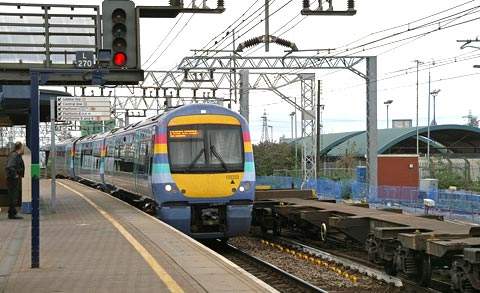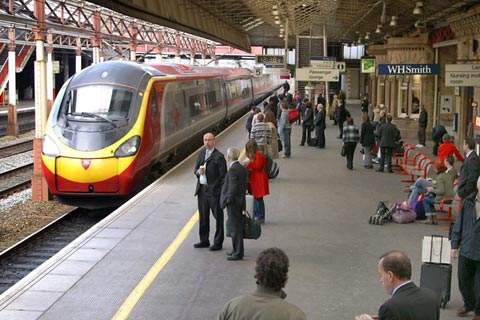London’s already extensive railway network is being made ready for the Olympic Games, to be hosted at 33 venues (17 for the following Paralympics) by the UK’s capital in 2012. In a turnaround from London’s transport being a stumbling block in the failed 2000 Games bid, by the July 2005 announcement of the success for 2012, the projected travel arrangements had become perceived as a strong point.
Although now approved and due to open by 2017, the long-standing Crossrail scheme was not deemed to have been required as an essential element in the Olympic Transport Plan for 2012.
Public body Transport for London (TfL) played a key role in securing the Games for London. The Underground, Docklands Light Railway (DLR) and the heavy rail routes incorporated as Overground in 2007 that run over Network Rail infrastructure in the process of major improvements, including new lines, enhancements to current infrastructure and new rolling stock.
The Games’ focal point is the main Olympic Park being built, partly on former railway land, at Stratford in east London. There are three other Olympic venues in east and south-east London. A few events will be in the very centre of the city, with rowing to the west of London near Windsor. The football tournament is to be spread around the UK, and sailing will be 135 miles (217km) from London on the south coast at Weymouth.
As a summer event, the Olympics occur when UK rail demand normally dips, as holidays remove many commuters from the system. This will mean that the net effect of the Games in terms of traveller numbers should not be as great as elsewhere in the year.
The project
There has been a focus on arrangements for visitors moving around London, although for UK residents, Network Rail and many train operating companies will supply a principal means of getting to Olympic events from across the country. To encourage public transport use, no parking arrangements except for officials and those with disabilities are projected.
All event tickets will include a Travelcard capability for use of the TfL system for that day. The Olympic Delivery Authority (ODA) is responsible for Games infrastructure and the Olympic Transport Plan. Published in draft form in 2006, it is subject to revisions. Detailed transport plans for each venue are being prepared.
Even with the array of rail connections scheduled for the main Olympic Park, further upgrades are needed ahead of 2012. Many improvements were planned prior to the announcement that London had won the bid.
By 2008 the Underground was carrying 1,014 million annually, and overall TfL daily carries vastly more people into London than the combined National Rail train operators. TfL Underground is undergoing a massive upgrade programme of refurbishment, including track relaying to improve reliability and ride quality, also the refurbishment of all the stations before 2012.
Expecting to rise from the 67 million annual rate for passenger journeys of 2008 to 100 million by 2012. DLR already serves London City Airport (in the former east London dockland area), which is expected to play an important part in the Olympics.
By 2012 there will be a total of ten public transport lines feeding into Stratford, representing the capability of a train arriving in the area every 15 seconds.
The centrepiece service will be the ‘Olympic Javelin’, taking seven minutes on the St Pancras-Stratford International section of High Speed 1 (formerly Channel Tunnel Rail Link). Capacity will be up to 25,000 people per hour each way between St Pancras and Olympic Park. It will also extend to Ebbsfleet International on the south-eastern edge of London for motorway park-and-ride access, also offering connections with Eurostar services from France and Belgium without having to go into central London.
Infrastructure
The majority of the infrastructure work involved is taking place in the Stratford area. In the heart of the future Olympic Park is the sub-surface Stratford International station on High Speed 1, completed by 2007 but not opened along with the line itself. Ramps at the 1km-long station give access to the newly built Eurostar depot nearby at Temple Mills. On what is now the Olympic Park site, Thornton’s Fields carriage sidings have been replaced with the new Orient Way facility, also at Temple Mills.
Already one of London’s most important rail interchanges, the existing Stratford station (to be renamed Stratford Regional) has seen heavy investment in recent years, with more to come. A new high-level DLR station to replace a much smaller original was completed in 2007.
This will be followed by existing low-level platforms on the former North London Line being converted to DLR use. Now within TfL Overground, North London Line services covering north and west London will be redirected from January 2009 to high-level platforms at Stratford.
The abandoned North London Line alignment towards the south forms the core of the 5km (3.1 mile) Stratford International to Canning Town extension, due to open in 2010. With new and reworked stations en route, this will be the main public transport corridor between the Olympic Park’s Stratford International DLR station and several Olympic disciplines being hosted at the ExCel venue, adjoining Custom House DLR station.
Another DLR extension due to open in early 2009 takes the system south of the Thames to a new terminus at Woolwich Arsenal, a heavy rail interchange and near the Royal Artillery Barracks shooting venue. The Cutty Sark stop on the DLR Lewisham line opened in 1999 is one of the rail links to the equestrian event venues at Greenwich Park.
Between 2006 and 2011, £1bn annually is being invested in the Underground, on projects including station refurbishment and track upgrading. Crucial to moving crowds around in London at any time, the Underground will be the speediest way between central London venues and the concentrations to the east, notably via the Jubilee and Central lines.
The key project is the series of measures that will give an overall 46% increase in capacity on the Jubilee line which will provide the link to the Olympic Park as well as the O2 complex (former Millennium Dome) and central venues, also ExCel via the Canning Town DLR interchange. As part of the £100m investment programme by the ODA at Stratford Regional, access to the Central Line, which runs along the same axis as mainline tracks, is being improved.
By 2012, with £1.4bn of investment in place, TfL’s Overground network should be an established high-volume part of the London Olympics transport operation. It will provide more integration with other services and line extensions, notably the East London Line which is due to reopen as part of TfL Overground in 2010. Network Rail’s largest project for the area in advance of the Olympics, Thameslink expansion, will also be in situ, giving much improved access and interchange facilities with TfL, mainly on a north-south axis.
Rolling stock
The highest-profile rolling stock order is for the flagship Class 395 trains that will operate the Olympic Javelin services. A total of 29 Hitachi six-car electric multiple units capable of 140mph (225km/h) were ordered for the high-speed domestic commuter services on High Speed 1 and feeder lines in Kent. .
Delivered for testing from 2007, Class 395 incorporates Japanese ‘Bullet Train’ technology and is due for fleet operation by 2009.
Bombardier won the main contract for 1,738 new Underground cars for delivery between 2008 and 2015. The Jubilee line has secured extra cars to strengthen current train formations for coping with higher passenger volumes.
Bombardier also won the contract to build a fleet of 44 Class 378 ‘Capitalstar’ units for TfL Overground, subsequently expanded by orders for extra coaches to create all four-car formations. Formal handover of the first of the new trains took place at Bombardier’s Derby Litchurch Lane factory in September 2008. Of value as a connecting service on the non-electrified orbital route around north-east London, the Gospel Oak-Barking service will also have gained new stock by 2012 with new Class 172 diesel units, also from Bombardier.
Positioned as the pivotal rail system for the Olympics in terms of final access to so many venues, the DLR is expanding its fleet with orders for 55 trains, a notional 22 half-units being in part funded by the ODA. Also from Bombardier, the first of the B2007 units entered revenue service in September 2007. The DLR capacity enhancement programme that will allow use of the system by three-unit trains (giving 50% extra passenger space per train) will have been completed well in advance of 2012.
Signalling and communications
A £600m contract was awarded for the complete resignalling of the Underground’s Jubilee and Northern Lines to increase capacity and reliability. The Victoria Line is undergoing a substantial upgrade and stock renewal. The new Jubilee Line system will also allow full use to be made of newly-lengthened trains on the cross-city route. With such a diverse international influx of visitors, crowd marshalling and communications will assume greater importance during the games.
TfL’s operations will much modified for the duration of the Games. Network Rail will be priovidng for increased frequencies and extended hours of operation by the service franchise holders on the ‘Great Eastern’ and London-Tilbury lines that cross the main Olympic zones.
The future
Dates of 2012 Olympic events are 27 July–12 August and Paralympics, 31 August–11 September. By this time, London, especially eastern London, will have gained a rail transport infrastructure of a standard and comprehensiveness that would have defied belief a decade earlier and will yield benefits for many years ahead.











